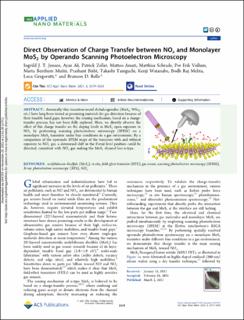| dc.contributor.author | Jensen, Ingvild Julie Thue | |
| dc.contributor.author | Ali, Ayaz | |
| dc.contributor.author | Zeller, Patrick | |
| dc.contributor.author | Amati, Matteo | |
| dc.contributor.author | Schrade, Matthias | |
| dc.contributor.author | Vullum, Per Erik | |
| dc.contributor.author | Benthem, Marta | |
| dc.contributor.author | Bisht, Prashant | |
| dc.contributor.author | Taniguchi, Takashi | |
| dc.contributor.author | Watanabe, Kenji | |
| dc.contributor.author | Mehta, Bodh R. | |
| dc.contributor.author | Gregoratti, Luca | |
| dc.contributor.author | Belle, Branson | |
| dc.date.accessioned | 2022-09-08T13:16:29Z | |
| dc.date.available | 2022-09-08T13:16:29Z | |
| dc.date.created | 2021-03-02T21:20:46Z | |
| dc.date.issued | 2021 | |
| dc.identifier.citation | ACS Applied Nano Materials. 2021, 4 (4), 3319-3324. | en_US |
| dc.identifier.issn | 2574-0970 | |
| dc.identifier.uri | https://hdl.handle.net/11250/3016660 | |
| dc.description.abstract | Atomically thin transition-metal dichalcogenides (MoS2, WSe2, etc.) have long been touted as promising materials for gas detection because of their tunable band gaps; however, the sensing mechanism, based on a charge-transfer process, has not been fully explored. Here, we directly observe the effect of this charge transfer on the doping levels in MoS2 upon exposure to NOx by performing scanning photoelectron microscopy (SPEM) on a monolayer MoS2 transistor under bias conditions in a gas environment. By a comparison of the operando SPEM maps of the transistor with and without exposure to NOx gas, a downward shift in the Fermi level position could be detected, consistent with NOx gas making the MoS2 channel less n-type. | en_US |
| dc.language.iso | eng | en_US |
| dc.publisher | ACS Publications | en_US |
| dc.rights | Navngivelse 4.0 Internasjonal | * |
| dc.rights.uri | http://creativecommons.org/licenses/by/4.0/deed.no | * |
| dc.title | Direct Observation of Charge Transfer between NOx and Monolayer MoS2 by Operando Scanning Photoelectron Microscopy | en_US |
| dc.type | Peer reviewed | en_US |
| dc.type | Journal article | en_US |
| dc.description.version | publishedVersion | en_US |
| dc.rights.holder | © 2021 The Authors. Published by American Chemical Society | en_US |
| dc.source.pagenumber | 3319-3324 | en_US |
| dc.source.volume | 4 | en_US |
| dc.source.journal | ACS Applied Nano Materials | en_US |
| dc.source.issue | 4 | en_US |
| dc.identifier.doi | 10.1021/acsanm.1c00137 | |
| dc.identifier.cristin | 1895083 | |
| dc.relation.project | Norges forskningsråd: 295864 | en_US |
| dc.relation.project | Norges forskningsråd: 280788 | en_US |
| dc.relation.project | Norges forskningsråd: 197405 | en_US |
| cristin.ispublished | true | |
| cristin.fulltext | original | |
| cristin.qualitycode | 1 | |

